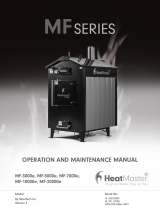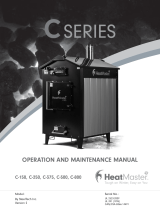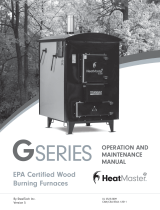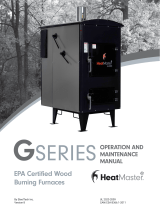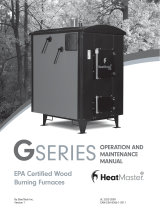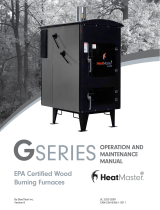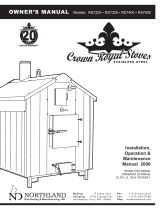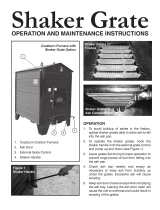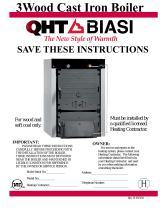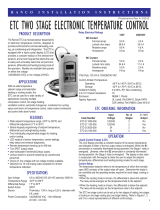Page is loading ...



Contents
Warranty and Safety
Limited Lifetime Warranty . . . . . . . . . . . . . . . . . . . . . . . 4
Water Treatment and Testing . . . . . . . . . . . . . . . . . . . . . 5
Water Treatment Policy . . . . . . . . . . . . . . . . . . . . . . . . . 5
Safety Precautions . . . . . . . . . . . . . . . . . . . . . . . . . . . . 6
Chimney . . . . . . . . . . . . . . . . . . . . . . . . . . . . . . . . . 7
Installation
Location . . . . . . . . . . . . . . . . . . . . . . . . . . . . . . . . . . 7
Furnace Foundation . . . . . . . . . . . . . . . . . . . . . . . . . . . 8
Trench . . . . . . . . . . . . . . . . . . . . . . . . . . . . . . . . . . . 8
Wiring . . . . . . . . . . . . . . . . . . . . . . . . . . . . . . . . . . . 9
Hydronic Lines . . . . . . . . . . . . . . . . . . . . . . . . . . . . . . 9
Furnace Connection . . . . . . . . . . . . . . . . . . . . . . . . . . . 9
Operation
How it Works . . . . . . . . . . . . . . . . . . . . . . . . . . . . . . 12
Filling the Furnace With Water . . . . . . . . . . . . . . . . . . . . 12
Firing the Furnace . . . . . . . . . . . . . . . . . . . . . . . . . . . 12
Care and Maintenance . . . . . . . . . . . . . . . . . . . . . . . . 15
Troubleshooting . . . . . . . . . . . . . . . . . . . . . . . . . . . . 16
Electrical Schematics Ranco Control . . . . . . . . . . . . . . .18-19
. . . . 20
Control and Settings . . . . . . . . . . . . . . . 21
Unit Footprints . . . . . . . . . . . . . . . . . . . . . . . . . . . . . 22
Replacement Components List . . . . . . . . . . . . . . . . . . . 23

LIMITED LIFETIME WARRANTY
SteelTech Inc. warrants to the original owner of the
Heat aster
SS
outdoor furnace that it is free from defects in
workmanship and material which could cause a leak
corrosion (if the instructions in the owner’s manual for
water treatment and maintenance are followed) for
The ife of the furnace toward the purchase of a new
Heat aster
SS
furnace, in the following pro-rated schedule.
Warranty schedule: coverage in the initial 5 years is 100%
Year 6-7 is 50%
Year 8-9 is 40%
Year 10-15 is 30%
Year 16-Life is 10%
Grates and Firebox door have a warranty of 5 years at
100%.
Ash Pan is covered for corrosion protection for a period
of one year.
In addition, all steel components including housing, legs,
etc. have a pro-rated warranty for a period of 10 years
with coverage reducing by 10% per year. Any parts not
manufactured by SteelTech Inc. that are used on the
furnace such as fans, aquastats, limit switches, pumps, heat
exchangers, etc carry their own manufacturer’s warranty,
normally one year. SteelTech Inc. will not be liable for the
cost of shipping, labor, replacement or repair of these
parts.
If warranty requires removal or replacement of the furnace
or a part of the furnace, SteelTech Inc.
and their dealers
are not responsible for the cost of labor, replacement
of antifreeze or water treatment, shipping cost or any
other cost other than the replacement component or
furnace. SteelTech Inc. always has the right to decide if a
part or furnace will be repaired or replaced and will not
be liable for any cost not authorized by a SteelTech Inc
representative.
SteelTech Inc. does not warranty any damage caused
due to burning improper fuels such as oils or plastics,
negligence and deterioration due to lack of proper
ongoing maintenance, physical damage caused by
abuse or freeze up, power surges
or unauthorized work
always have a back up heating system installed in case of
disruption in the outdoor furnace heating system.
SteelTech Inc. is not liable for any damage or cost which
may occur from or during the operation of the furnace
or damage incurred due to any heating system failure.
The purchaser assumes all responsibility for the care,
maintenance and safe operation the furnace including
adding of approved boiler treatment or water. SteelTech
To qualify for warranty all instructions must be followed
in operator’s manual, water must be tested and
maintained a minimum of once per year, and warranty
of purchase along with a copy of the original invoice.
No warranty can be approved unless the warranty
SteelTech Inc. reserves the right to change conditions of warranty
at any time.

WATER TREATMENT AND TESTING
Water Treatment Policy
To qualify for warranty, water must be tested a minimum
of once per year and water treatment added when
necessary.
To take a water sample:
Locate your water sample bottle, mailing carton and
mailing label provided to you by your dealer.
Open the boiler drain located at the bottom of the
rear of the furnace for 10-15 seconds or until the water
runs clear. CAUTION: Water is hot! Use extreme care
or a bucket to run water into and let cool before
collecting sample.
Fill one of the test bottles at least 1/2 to 2/3 full.
Fill out the mailing label provided with the test bottle
completely, including your email address, the model
number and serial number of your furnace. Make sure
to note if the furnace water contains any antifreeze or
additional chemicals.
Attach top part of label to sample bottle and bottom
part to outside of mailing tube. Place bottle in tube.
Mail to our testing lab. Results can take up to 4 weeks
to receive and up to 8 weeks if no email address is on
hand at Heat aster
SS
.
You will receive a water test report outlining what must
be done (if anything). If any action is necessary, take
another sample and mail it to our test lab again to
verify the recommended changes have been made.
water or after testing, if needed. Ensure that all drains are
closed. It is recommended that water treatment is added
accordingly based on the water test results. Additional
treatment may have to be added for water with more
severe properties or for systems with more chemically
demanding requirements.
Recommended operating levels are as
follows:
Conductivity: 100 – 4000 ppm
pH: 8.5 – 10. 5
Nitrates: no less than 730 ppm
Test Parameters and What They Mean
Conductivity
Conductivity is a measurement of minerals in your
furnace water. While it is common to have minerals in
water, excess minerals can cause many problems in
hydronic systems including scaling and corrosion.
pH
pH is measurement of alkalinity (hard or soft water). For
outdoor furnace water and the water treatment used in
outdoor furnaces it is better to have your water a little
harder than softer (recommended pH range is 8.5-10) as
the active ingredients in the water treatment neutralize
harder water easier than softer water
Nitrates
Nitrates tested for are a measurement of how much
water treatment is in the water. Nitrates measured are
active units of water treatment available to neutralize
harmful elements in your furnace water. Nitrates also act
to neutralize harmful bacteria that may build up in the
furnace water over time.
Glycol
Inhibited glycol provides anti-corrosion elements and
freeze protection for outdoor furnaces and is compatible
with Outdoor Furnace Water Treatment. Because outdoor
furnaces are open to the atmosphere systems and will
have fresh water added occasionally, oxygen is always
entering the system and will break down the glycol over
time to create glycolic acid which will harm your furnace
system. When this happens you will be required to drain
It is always suggested to use 100% virgin
glycol instead of recycled glycol as it will break down
much sooner and create glycolic acid.

SAFETY PRECAUTIONS
Read and understand all precautions before operating the
furnace.
Save these instructions. Retain this manual as long as
you own your Heat aster
SS
furnace. Carefully read
and follow these directions.
IMPORTANT
THESE FURNACES ARE FOR WOOD AND COAL
BURNING ONLY. Follow all applicable local laws.
DANGER
rubber, plastics or garbage. Only competent persons
with a sound understanding of this heating method
warranty.
Do not burn garbage, gasoline, drain oil or other
Do not operate with fuel loading or ash removal doors
open
Do not store fuel or other combustible material within
marked installation clearances
Maximum draft marked on nameplate
DO NOT CONNECT THIS UNIT TO A CHIMNEY FLUE
SERVING ANOTHER APPLIANCE
WARNING
All installations and operations of your Heat aster
SS
product must follow STATE, PROVINCIAL, and LOCAL
LAWS pertaining to operations, wiring, plumbing and
building codes.
All models operate at atmospheric pressure. DO NOT
way which is located on top of the boiler either in front
of or behind the chimney.
When installing the furnace, the chimney should
appliance.
water. It will cause serious damage to the furnace.
All covers or guards must be in place at all times, except
for maintenance or service.
ATTENTION
A copy of the owner’s manual in French is available by
request from Heat aster
SS
The person(s) operating this furnace must comply
with all applicable local and state laws or other
Do not remove labels from furnace except in the case
of servicing.
CAUTION
Use of an approved spark arrester is recommended.
It is the recommendation of SteelTech Inc that
a 15' minimum distance of clearance from buildings
and other combustibles. Your local authorities and
your insurance company may require a greater
distance. Never allow combustible material to
accumulate near the unit. Fuel should never be stored
where there is the
Load carefully or damage will result.
Do not start or operate furnace without checking
comes
out of vent pipe on the top of the furnace.
Hot Surfaces: Keep children away. Do not touch
during operation.
RECOMMENDED
Choose the location of your furnace with concern wind
direction, smoke odor, sparks, blocked viewing and fuel
storage carefully. Be a responsible and considerate owner.

Chimney
The chimney on your HeatMaster
SS
outdoor furnace
is a stainless steel double wall insulated chimney. It is
attached to the furnace with a stainless steel adapter. To
install chimney extensions be sure to purchase the same
chimney as on your furnace (Selkirk Ultra Temp). These
chimneys are a twist lock connect chimney. Be sure to
use the chimney fastening ring to fasten the connection
through your dealer. It is not recommended that the
chimney be longer than 15 ft.
appliance.
good condition. See below for chimney sizes.
MF-3000e – 6" Stainless Steel Double Wall Chimney
MF-5000e – 6" Stainless Steel Double Wall Chimney
MF-7000e – 6" Stainless Steel Double Wall Chimney
MF-10000e – 8" Stainless Steel Double Wall Chimney
MF-20000e – 10" Stainless Steel Double Wall Chimney
NOTE: Chimney extensions and caps are useful for lifting
exhaust gases and smoke away from buildings. However,
when burning a MF Series furnace keep in mind that the
cooler exhaust temperatures as a result
excess
condensation when chimney extensions and caps are
used. This can lead to improper burning in the furnace. A
taller chimney also greatly increases the risk of
overheating due to the extra draft caused by the
FURNACE INSTALLATION GUIDE
THESE FURNACES ARE FOR WOOD AND COAL USE ONLY.
FOLLOW ALL APPLICABLE LOCAL LAWS
LOCATION
Maintain adequate clearance buildings and
combustibles. Store fuel outdoors under cover. Do not
place or store fuel or allow debris to accumulate within
stove installation clearances or within the space required
for charging and ash removal. Never install the furnace in
the fuel storage building.
Contact all governing authorities in your area prior to
installation.
When choosing the location of your furnace you should
consider prevailing wind direction, distance from home for
refueling and fuel storage and give consideration for any
effect on your neighbors.
CLEARANCES TO COMBUSTIBLES
he following clearances to combustibles must
result.
Minimum Clearance to Combustibles
Sidewall to Furnace 0"
Back Wall to Furnace 36"
Front of Furnace 36"

FURNACE FOUNDATION
Inspect the ground conditions that you intend to install
your furnace on. If the area is unstable or has a history
of staying wet you may have to improve the soil with
gravel as well as raise the level of furnace placement.
A cement pad of 4-6" in thickness should be used.
The furnace in most cases can be placed on 4 cement
blocks not less than 6" wide x 10" long and 3" thick.
The furnace should never be installed on a combustible
Never allow combustible material to accumulate on the
furnace foundation.
Do not install on a combustible base
Find the footprint of the furnace you have purchased
and place your blocks
so the legs will stand on the center of the blocks. Cement
pads should be a little bigger than the actual furnace, with
about a 4' extra length front and back so you have a solid
working area.
TRENCH
SteelTech Inc recommends the trench to be 24" to 36"
deep and wide enough to install your water lines. Take
into consideration soil conditions as rocky soil conditions
can cause the casing of the pipe to be damaged and
trench with sand.
If possible, have a gradual slope in your trench to allow
drainage away from your lines and out of trench bottom.
Most insulated underground pipe has room for electrical
wire in it. If it does not, place electrical supply in bottom
of trench and cover with 6 inches of dirt. A minimum of
R8 insulation value is recommended and a water tight
vapor barrier such as PVC pipe or drain tile to encase your
insulation is a must.
NOTE: It is recommended that only high quality, well
insulated lines are used. Poor quality
you determine the best line to purchase.
NOTE: If you are installing your water lines under an area
where vehicles will cross, you should increase your depth
of the trench and use a schedule pipe over your lines to
reduce the pressure generated on the lines.

WIRING
All wiring must conform to local codes. Use an electrical
wire rated and approved for underground installations.
This wiring can be placed in the same trench below the
water lines.
be present when installing the electrical portion of the
hook-up.
ee Pages 1 -1 for the furnace wiring diagrams.
HYDRONIC LINES
Hydronic lines (hot water heating lines) whenever buried
or encased in cement should not be spliced. Take the
necessary steps to ensure they stay dry. This ensures
that minimal heat loss occurs. Supply and return lines
should be a minimum of ¾" diameter, although 1" is most
common, and have a rating of 100 PSI capacity at 180
degrees Fahrenheit. This pipe should be listed for potable
water.
Hint: Mark your feed and return lines prior to covering
and allow enough pipe above ground at both ends for
a relaxed connection. Red lines are generally “hot” while
blue are usually “cold.”
FURNACE CONNECTION
Connections to the furnace are clearly marked.
Return (from the building) are the top ports, Supply (to the
building) are the bottom ports. The installation of isolation
valves at both ends of the pump is recommended as well
as a valve at the return line. This will allow you to shut off
water supply if repairs or additional heating components
are added to the system. Your main power is connected
NOTE: A supply of fresh air is necessary for combustion
and ventilation. Do not block fresh air intake located at the
back of the furnace.

At least one pump must be circulating at all times or the
water in the furnace may boil. A continuous pump is also
useful for freeze protection in temperatures below 32
degrees F.
It is important to calculate the BTU’s needed, line size,
size circulating pump is needed. Undersized lines or long
The best place to mount the main pump is on the supply
outlet. Placing the pump inside the building can lead to
cavitation and air-lock problems.
Building Connections
A hole large enough to accommodate the water lines,
insulation and PVC piping is important. Attention
sealing this point with a weather proof insulation on
both sides is also important.
Interior Connections
You may require either a water-to-water (tube and shell
or plate) or a water-to-air exchanger (rad) to transfer heat
energy from the hot water your furnace has produced.
Your plumber or dealer can design and install a system to
IMPORTANT: It is recommended to always have a back
up heating system installed in case of disruption in the
outdoor furnace heating system.
The following are examples of basic interior connections.
SteelTech Inc. carries the necessary parts for installation.
Contact us for more information!
DISCLAIMER: The following information in the interior
connections are examples and suggestions only. When
installing a furnace and its parts it is best to talk to your
To maintain pressure in an existing boiler while using an
outdoor furnace a water-to-water heat exchanger is used.
The water-to-water exchanger is installed in-line on the
return side of the existing pressurized boiler system.
Operate the (gas, oil, electric) boiler periodically to
ensure that it will operate satisfactorily when needed.
Do not relocate or bypass any of the safety controls in
the original (gas, oil, electric) boiler installation.
acceptable operation before and after installation of the
the regulatory authority.
Do not connect to any chimney or vent serving a gas
appliance.
The installation should comply with requirements of CAN/
CSA-B365, and changes to the installation should comply
Any installation of an add-on boiler shall:
be installed without interfering with the normal delivery
of heated water from the original boiler,
be installed without affecting the operation of the
electrical and mechanical safety controls of the original
boiler,
provide for a changeover from one fuel to the other
components other than the thermostats,
have provisions for preventing, or adequate water
capacity within the boiler to prevent damage from loss
of circulation due to electrical power failure,
be installed without changing the function of the
controls or rewiring the original boiler. A wiring
interconnection is permitted. The electrical system of
both boilers shall be powered from a single branch
circuit without exception.

INTERIOR CONNECTIONS (continued)
When circulation is reduced because of an electrical
power failure the installation of a hot-water circulation
loop that will dissipate at least 10% of the estimated rated
heat output of the solid-fuel boiler is recommended with
the following guidelines:
The loop can only be made inoperative by a deliberate
manual action.
The design parameters for sizing shall be a pipe size >
3/4 inch (18 mm), room temperature of 65° F (18° C),
and mean water temperature of 180° F (82° C).
The loop be positioned above the boiler, with features
that promote natural thermal circulation of the water.
The piping used in the system should not cause any
restrictions that could create excessive pressure in the
system. Eg. Reducing from 1" pipe to ½" pipe
Systems
Flat plate exchanger systems that are used with
baseboard systems help to heat the water going in to
the pressurized system while keeping the two systems
separate. Because an outdoor furnace is an open system
(not pressurized) and the system tied in to in this type of
application is pressurized it allows both systems to stay the
same while being operational.
The water supplied by the outdoor furnace will heat the
water in the pressurized system while the present heat
source in the pressurized system (such as a boiler) can be
used as a back up heat source in case of emergency or
need for additional heat.
Domestic Hot Water
Flat plate exchanger systems used to pre-heat domestic
and more reactive to hot water demands then tube and
shell (sidearm) systems. They are mounted on the supply
line and pre-heat the water going in to the hot water tank.
Forced Air Furnace (Water-To-Air
The water-to-air heat exchanger must be mounted so that
mounted below the A/C coil if possible. The exchanger
produce about as many BTU’s as the existing heat source.
An exchanger that produces too many BTU’s will result
in uneven heat and the fan stopping too quickly while a
heat exchanger that is undersized will not produced the
necessary BTU’s.
On systems with Air Conditioning it is very important
freeze up. Using standard outdoor furnace 3 row coils, a
minimum of 80 sq. in. of coil should be used per ton of
cooling. Exchangers can be mounted in cold air returns
but greater care must be taken as heat from the exchanger
can interfere with the air handler controls and/or sensors.
It is important that the warm-air supply-duct system be
constructed of metal in accordance with NFPA 90B-1993,
2-1.1 if the outlet-air temperature of a central furnace
exceeds 250° F (121° C) when it is tested in accordance
with the requirements for Simultaneous Firing in 56.4.1
and 56.4.2 of the standard. It is also important that the
plenums installed to the furnaces be constructed of metal
in accordance with NFPA 90B-1993, 2-1.3.

ed baffle
ss baffle
offic
OPERATING THE FURNACE
HOW IT WORKS
The MF Series furnace is a 409 stainless steel outdoor
reservoir of hot water is pumped through insulated lines
to buildings, pools, greenhouses or whatever is being
heated.
water temperature, sending power to the
and draft fan when the water temperature gets too low.
When the furnace calls for heat, the opens
the
the box and under the grates cooling them even during a
hot burn.
the back and up the chimney. This triple pass is a simple
and very effective heat exchanger, lowering exhaust
temperatures and also extinguishing sparks as they travel
back and forth over the long distances. The MF-20000e
model utilizes a double instead of a triple pass.
When the aquastat senses the water is up to the high
temperature setting, it shuts off the fan and the
The furnace is normally loaded every 12-24 hours and
ashes are removed when needed using the ash rake,
shaker grate and ash pan.
FILLING THE FURNACE WITH WATER
Your furnace has a vent pipe that protrudes through
temperature. Add water when it reaches half way down
the gauge. Allowing the furnace to run low on water will
cause the furnace to overheat and cause damage to the
hazard. This is an open system so the unit
cannot be pressurized. If you overheat and
boil the water in the furnace immediately
the problem.
Hint:
using the vent pipe, it is recommended
building you’re heating with a one
Filling the furnace with the inline valve
pushes all the air towards the furnace and out of the vent.
Because this furnace is an open system it is normal that
water will have to be added annually.
CAUTION:
Allow furnace to run for 2 days and check system water
your initial water sample at this time and be sure that it is
sent in to Heat aster
SS
FIRING THE FURNACE
wood and coal and as such, are not intended for burning
any other fuels such as rubber, oil, plastic or garbage.
Burning these fuels in your furnace will result in the
warranty on the furnace being voided.
WARNING – Risk of Fire
Do on operate with fuel loading or ash removal doors
open.
Do not store fuel or other combustible material within
marked installation clearances.
CAUTION – Hot Surfaces
Keep children away. Do not touch during operation.
ed baffle
ss baffle
offic

WOOD
The quality of your wood fuel can greatly affect the
burning air dried seasoned hardwoods (15-20% moisture
content), as compared to softwoods or green or freshly
cut hardwoods. Typically it takes at least 12 months to
properly season wood. Seasoned wood looks dark, or
gray when compared to green wood – but if you split a
piece of seasoned wood – it’s white on the inside. It has
cracks running through each piece, and a lot of little cracks
on the inner rings. Unseasoned wood has a wet, fresh
looking center, with lighter wood near the edges or ends
very fresh, the bark will be tightly attached.
Using a moisture meter to test your wood
You can use a moisture meter to test how wet your wood
is. A moisture meter will measure the moisture content of
a piece of wood by inserting the metal prongs into the
grain of the wood. The moisture content will be displayed.
To get an accurate reading make sure to use a high quality
moisture meter, split the wood and take at least 2-3
readings from different points of the wood
Storing Wood
Store your wood pile under an open ended shelter to
avoid rain and snow buildup on the pile. Keeping 3 sides
open will allow the sun and wind to season the wood. Do
not keep wood in a woodshed or under a tarp in summer
as the moisture that evaporates from the wood will have
nowhere to go.
Loading
Once a hot coal bed is established, pile small pieces
established.
Load larger pieces of wood until the
desired burn time.
Load only what you need for
the next 12-24 hours as
overloading the furnace
COAL
ATTENTION:
reach what is called the dew point. This creates a sweating
is normal.
Hint:
capacity. Smaller fuel loads burn hotter, cleaner and more
thoroughly. By burning off more of the gases (smoke),
increas
heat transfer to the water.
Coal varies widely depending on the type of coal and
properties of the seam that it was mined from (ash
loaded, etc is normal because
of this. If you experience
try coal from a different
source.
CAUTION:
door to refuel. Coal generates very explosive gases and
(Furnace On/Off Switch on Control Panel) and open the
door to the second latch point to allow it to vent the gases
for at least 15 seconds. Only open the door up when you
are sure it is safe to do so, keeping your face and body
well away from, below and behind the door.
Only open the door long enough to refuel. A door left
yourself and damaging the furnace.
Loading
1. Once a hot coal bed is established, load a deep pile

2. Be sure to leave a small air hole at the front of the
pile (near the secondary air vent) to maintain enough
3. Load only what you need for the next 12-24 hours as
4. DO NOT pile coal above the bottom edge of the door
may occur.
Cleaning and Removing Ash and Clinkers
Occasional breaking up of the crust that forms on top of
the fuel load may be needed. When the pile burns down,
ash fall through. Use the Shaker Grate Handle to rattle the
leaving
coals and unburned fuel on top of the grate with access to
air for proper burning. Allowing a small amount of ash to
accumulate on either side of the grate will keep
center of the
grate open so the burn rate is correct.
A
lways empty the ashes after shaking them down. If any hot
coals are shaken down they can ignite when the draft comes
back on and create a super-heated environment in the ash
pan. This can cause the ash pan and grates to warp and is
not covered under warranty. Always lift the ash pan slightly
as you slide it in so the front edge scrapes the ash box clean.
This will keep the pan level and prevent air leakage. Be sure
ash pan is closed tightly before you leave.
Shaker Grate Dump Mode
Do not try to force all the clinkers through the grate as it
amount of ash, use the Dump feature. To use the Dump
feature:
unburned fuel in to the ash pan
2. Open the ash drawer a minimum of 1"
3. Shake the Shaker Grate Handle using the full range to
tilt the grates back and forth up to 45° to dump ash
and clinkers in to the ash pan.
4. Close the ash drawer tightly.
If
clinkers are too large to dump through the grates into the
and lift them out the door with a shovel.Too many clinkers
accumulate too quickly you may have poor quality coal.
Some coal smolders better during off cycles than others.
Shortening the differential on the Ranco temperature
control to make it cycle more often can help but is a less
C
or creosote buildup can slow the burn rate and reduce
be removed by bending the tabs on the front right and
left corners down and sliding it forward. The top bypass
divider can slide completely out which will give plenty of
room to drag any ash forward and out the top clean-out
door (there is no divider in the MF-20000e model). Be sure
upside down. If wet creosote accumulates in the top of the
in loading, burn times o burn rate may be necessary to
prevent the furnace airways from becoming blocked.
GR ES OPEN
Shaker Grate
Handle

CARE AND MAINTENANCE
To obtain the high levels of performance of your
furnace, certain maintenance procedures are required
periodically to avoid soot, creosote and ash buildup.
On a daily basis you need to:
Check for ash and creosote buildup until experience
shows how often cleaning is necessary.
Ensure that the door gasket is sealing properly.
Ensure that door and ash drawer are closed and sealing
properly.
Check water level.
Check for sparks or coals that may have fallen from the
furnace and make sure they are safely disposed of.
On a weekly basis you need to
Remove ashes.
Check for ash and creosote build up in the bypass
trough, top heat exchange chamber and chimney. Fly
burn rate and create poor heat transfer.
Removal of creosote may be necessary in mild weather.
Burning your furnace with a larger differential at higher
temperatures means less creosote buildup.
On a seasonal basis when furnace is not in use, you will
have to:
Remove all ashes and excess creosote.
Remove the box from the rear of the furnace and
clean out an debris and ash that has built up
problems.
Clean out bypass trough and chimney.
Cover chimney and crack open the ash pan door
enough to allow air movement and reduction of
your system for leaks.
each side of the door.
CONTROLS AND SAFETY DEVICES
Furnace Control – Your Heat aster
SS
MF Series furnace
uses a factory-programed aqua stat control to maintain
your water temperature by to
open the air way and engaging the draft fan. The control
is
and displays the water temperature in your furnace.
Programming and troubleshooting instructions can be
found on page of this manual.
– The is located beside the
black metal airbox mounted on the rear of the furnace
and is a
The lift the
furnace
Draft Fan – The draft fan is located at the rear of the
furnace on top of the black metal airbox and is used to
the furnace is calling for heat.
High Limit Switch – The high limit cut off switch is used to
ensure the furnace does not cause damage via runaway
if the water temperature rises above 190° F.

draft inducer if used, is especially important at the end
of the heating season to minimize corrosion during the
summer months caused by accumulated ash.
Creosote and Fly Ash Formation and Need
for Removal.
ATTENTION: Have a clearly understood plan to handle a
When wood or coal is burned slowly, it produces tar
and other organic vapors, which combine with expelled
moisture to form creosote. The creosote vapors condense
The chimney and chimney connector should be inspected
at least twice monthly during the heating season to
determine if a creosote buildup has occurred. If creosote
has accumulated it should be removed to reduce the risk
Disposal of Ashes – Ashes should be placed in a metal
ground well away from all combustible materials before
or otherwise locally dispersed, they should be retained
in the closed container until all cinders have thoroughly
cooled.
CAUTION: Make certain that all electrical power to the
furnace and components is shut off. It can be washed
using water and a mild non abrasive cleaner suitable for
painted surfaces.
ATTENTION: Avoid direct water pressure to electrical
components and connections.
TROUBLESHOOTING
If the furnace is running but fails to bring water up to
temperature:
Check fan for operation.
Check that the damper and box elbow is
Check to ensure the furnace is sized accurately
according to heat demand.
Check fuel type. Poor quality fuel will not provide as
many BTU’s as high quality fuel.
Check water level of furnace.
7. Check for ash and creosote blockage at chimney and
bypass trough.
8. Check temperature settings. Make sure high
temperature setting is set to at least 165 F.
9. Check for power at furnace.
10. Check to ensure all pumps in the system are running.
11. Check to make sure there are no leaks, hot/wet spots
may cause the pipe to be saturated and lose its
insulation value.
12. Check Temperature of water exiting furnace, entering
the building being heated and before and after each
heat exchanger.
If the furnace water is hot but buildings do not have
heat:
1. Check to ensure all pumps in the system are running.
3. Check for air in the system at the exchanger by
bleeding off.
5. Check Temperature of water exiting furnace, entering
the building being heated and before and after each
heat exchanger.
If the furnace overheats:
Check that all doors are closing properly and that door
gasket is completely sealing.
Check that the damper plate is opening and closing
without hang-ups.
Check venting and fan box on rear of furnace for air
leaks.

4. Check that the temperature settings are correct. The
furnace should be set on Heating Mode (H1) and the
high temperature setting should be set no higher than
185° F.
5. Check chimney draft. If the chimney has been
extended too far or has a strong wind blowing over it,
it may cause a draft down the furnace.
6. Check water level.
7. Make sure the door and ash drawer are air tight.
8. Check to ensure all pumps in the system are running.
If the furnace has shut down:
1. Check to ensure that the unit has power (does the
light work?).
2. Check to ensure the Furnace On/Off switch is in the
On position.
3. Check the water temperature (furnace has a high
temperature cut out of 190 degrees F. and turns on
again at 140 degrees).
closed.
2. Close all combustion air inlets on the furnace.
If there is a power failure:
Depending on the system design, this may allow
convective circulation. NOTE: This does not apply to
will continue to operate normally without electricity.
2. It is important to remember that the heating systems
cannot dispose of a great deal of heat without the
DO NOT
LOAD LARGE AMOUNTS OF SOLID FUEL INTO THE
FURNACE! Fire the furnace cautiously until you are
able to determine how quickly the heat system is able
to absorb the heat being produced by the furnace.
and zone valves and resume normal operation of the
system.
If there is smoke leaking out of the door. Small amounts
of smoke leakage is normal due to the fan pressure and
restricted exhaust.
1. Check to ensure door is sealing properly.
2. If the seal is worn out it will have to be replaced.
the Door Latch Bearings and Door Hinge bearings
and set the door so it seals tightly against the door
1. Check to ensure the furnace is sized accurately
according to heat demand. If the furnace is oversized
it will idle and cause this. If the weather is warm or mild
until your next burn time (generally 12 hour burn time
is best). It will allow the furnace to burn more often
during idle, creating less creosote.
2. If the chimney and/or bypass become plugged with
creosote it will be necessary to scrape the creosote out
a week or more then a few gallons of water per week
1. Check the temperature settings and gasket on the
door and ash drawer to ensure the furnace is not
over temperature and steaming. If water temperature
reaches levels over 200 degrees Fahrenheit the water
will steam and water loss will occur.
2. Check the perimeter of the furnace for water puddles
collecting or dripping from the furnace. If water is
3. Check all plumbing in the system to ensure there are
no leaks.
The Ranco Temperature control is giving the user an
error message.
Instructions for dealing with Ranco ETC settings and error
codes are included in the owner’s manual on page 20.
120V AC
POWER SUPPLY
BLK
WHT
GRN
1
2
5
6
7
8
RED
WHT
BLK
BLUE
YELLOW
WHT
WHT
GRN
GRN
GRN
BLK
WHT
BLK
GRN
YELLOW
YELLOW
BLUE
WHT
RANCO ETC
FRONT LIGHT
WHT
BLK
WHT
BLK
GRN
BLK
GRN
GRN
WHT
WHT
TEMPERATURE
PROBE
HIGH
LIMIT
SWITCH
RED
RED
BLK
WHT
WHT
BLK
BLUE
BLK
BLK
COM
120
240
C
NO
NC
GRY
WHT
WHT
BLK
BLOWER
RED
GRN
SOLENOID
WHT
WHT
RED
LIGHT
SWITCH
FURNACE
SWITCH
TIMER
MF-3000e, MF-5000e, MF-7000e
3 4

MF-3000e, MF-5000e, MF-7000e

NC NO C
240 120 COM
Ranco
ETC
1
2
Damper
Actuator
Front Light
BLK
WHT
BLK
WHT
GRN
Grey
GRN
120V
Power
Supply
High Limit
Switch
Temperature
Sensor
Draft
Fan
Light
Switch
Furnace
Switch
Power
Switch
BLK
WHT
WHT
BLK
BLK
WHT
GRN
WHT
WHT
BLK
Draft
Fan
GRN
MF-10000e, MF-20000e

Description
The Ranco electronic temperature control (ETC) is
designed to provide on/off control for heating and
cooling. It is equipped with a liquid crystal display
(LCD) that provides a constant readout of the sensed
temperature, and a touch keypad that allows the user to
easily and accurately select the set point temperature,
differential and heating/cooling mode of operation.
Programming steps and Display
The ETC can be programmed in four simple steps using
the LCD display and three keys on the face of the control.
STEP 1 To start programming press the SET key once
to access the Fahrenheit/Celsius mode. The
Display will show the current status, either F for
degrees Fahrenheit or C for degrees Celsius. Then
press either the up or down arrow key to toggle
between the F or C designation.
STEP 2 Press the SET key again to access the set point.
The LCD will display the current setpoint and
the S1 indicator will be blinking on and off to
indicate that the control is in the set point mode.
Then press either the up key to increase or the
down key to decrease the setpoint to the desired
temperature.
STEP 3 Press the SET key again to access the differential.
The LCD will display the current differential and
the DIF1 indicator will be blinking on and off to
indicate that the control is in the differential mode.
Then press the up key to increase or the down key
to decrease the differential to the desired setting.
STEP 4 Press the SET key again to access the cooling or
heating mode. The LCD will display the current
mode, either C1 for cooling or H1 for heating.
Then press either the up or down key to toggle
between the C1 or H1 designation. (This setting
must remain at H1 for proper furnace operation
Press the SET key
once more and programming is complete.
NOTE: The ETC will automatically end programming if no
keys are pressed for thirty seconds. Any settings that have
been changed on the control will be stored at that point.
Step Indicator Description
1 F or C Fahrenheit or Celsius Scale
2 S1 blinking Setpoint Temperature
3 DIF1 blinking Differential Temperature
4 C1/H1 Cooling or Heating Mode
Troubleshooting Error Messages
Display Message
E1 Appears when either the up or down key is pressed
when not in the programming mode.
To correct: If the E1 message appears even when no
keys are being pressed replace the control.
E2 Appears if the control settings are not properly
stored in memory.
To correct: Re-set all settings. If the display continues
to show E2, replace the control.
EP Appears when the probe is open, shorted, or
sensing a temperature that is out of range
To correct: Check to see if the sensed temperature
is out of range. If not, check for probe damage
by comparing it to a known ambient temperature
between –30°F and 220°F. Replace the control if
necessary.
EE Appears if the EEPROM data has been corrupted.
To correct:
Replace the control.
CL Appears if calibration mode has been entered.
To correct: Remove power to the control for at least
appears, replace the control
Input Voltage: 120 or 208/240 VAC (24 VAC
optional), 50/60 Hz
Temperature Range: 30°F to 220°F
Differential Range: 1°F to 30°
Sensor: Thermistor, 1.94 in. Long x .025 in.
Dia. with 8 ft. cable
Power Consumption: 120/208/240 VAC: 100 Milliamps 24
VAC: 2-6 VA
/
